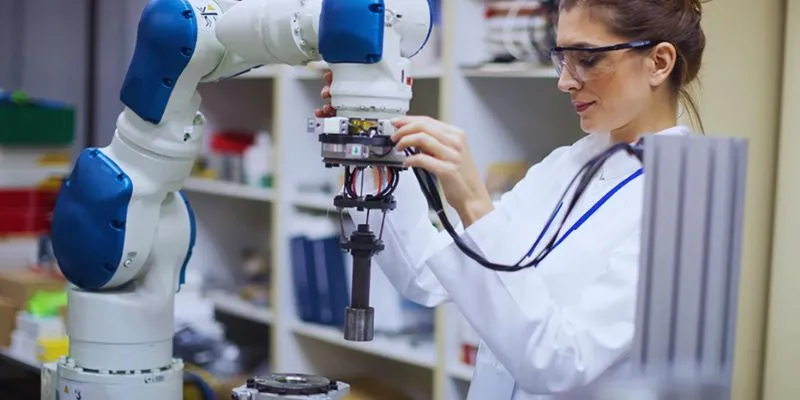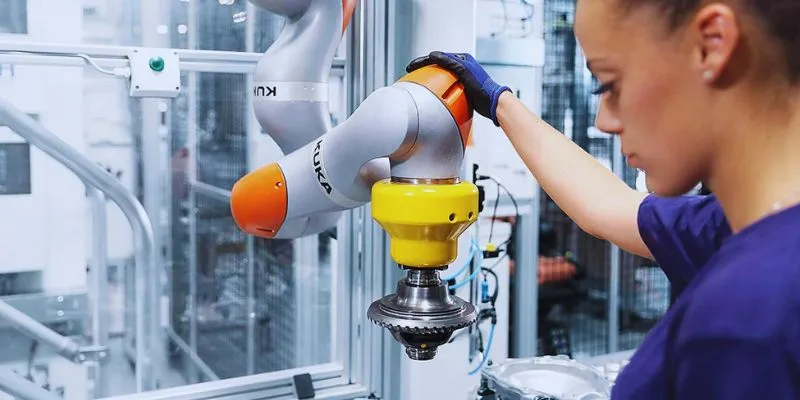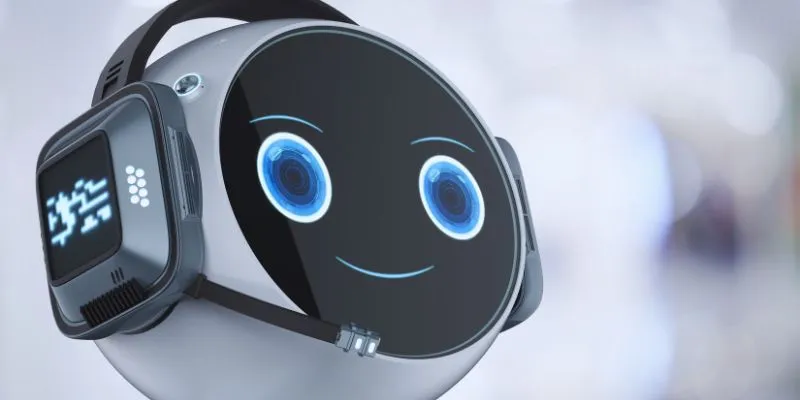Cobots—also known as collaborative robots—are revolutionizing the way humans interact with machines. Unlike conventional robots, cobots operate in shared environments alongside people. They are designed for ease of use, versatility, and safety, helping companies boost output, reduce strain, and streamline processes. Cobots are increasingly accepted in sectors such as manufacturing, logistics, and healthcare.
Both small and large businesses find cobots ideal due to their affordability and ease of programming. Their adaptability offers significant value across various sectors. Understanding how cobots work prepares teams for a better future. As demand rises, cobots continue to transform job completion. They serve as partners rather than replacements for human workers.

What is a Collaborative Robot (Cobot)?
A collaborative robot, or cobot, is designed to function safely alongside people. Unlike traditional robots that operate behind safety barriers, cobots work closely with humans in shared spaces. They utilize sensors and intelligent software for safe interaction, complementing employees rather than replacing them. Cobots are often smaller, lighter, and easier to operate, with user-friendly programming that allows even non-experts to teach new tasks quickly.
Cobots assist in tasks such as packaging, assembly, picking, and placing, relieving human workers from repetitive strain. They enhance group efforts, resulting in fewer injuries and greater efficiency. Particularly beneficial for small batch production, cobots offer rapid adaptability and increased flexibility. The global demand for industrial cobot applications continues to grow as more companies rely on them to meet consumer demands.
How Do Collaborative Robots Work?
Cobots operate using sensitive motors, artificial intelligence, and advanced sensors, allowing them to respond in real-time to their surroundings. When a human approaches, the cobot automatically slows down or stops to avoid collisions, thanks to built-in safety mechanisms. Most cobots have force- limiting joints that cease movement upon unexpected contact.
With artificial intelligence and vision systems, cobots can “see” their environment, learning tasks by example or following pre-programmed routines. Users can guide the cobot by moving its arm, enabling it to memorize actions for repetitive tasks. Cobots offer straightforward programming and can quickly adapt to new tasks without requiring coding knowledge. Additionally, cobots can interface with tools or other machinery, enhancing cooperation across systems. Understanding how cobots work helps companies integrate them smoothly into their operations.
Types of Tasks Cobots Perform
Cobots excel at low-risk, repetitive tasks, such as simple packing, quality inspections, and item assembly. They can also manage gluing, polishing, or welding tasks. In the food industry, cobots handle packing and sorting with precision. Laboratories use cobots to assist in test processing and sample transfers, while warehouses rely on them for order picking and goods movement. Cobots are also excellent at inspection tasks, using vision systems to detect product defects and improve precision through repetitive actions.
Cobots support machine tending by autonomously loading or unloading machines. In electronics, they handle the delicate insertion of small components, while the automotive industry uses them for tasks like bolt tightening and alignment. Cobots assist teams under pressure, reducing fatigue and enabling workers to focus on decision-making activities, thereby increasing efficiency and safety. As technology advances, their role in automation continues to grow.
Benefits of Using Cobots in Industry
Cobots offer numerous benefits to companies of all sizes. Their primary advantage is their ability to function safely alongside humans, often without the need for physical barriers, which frees up floor space in manufacturing settings. Cobots are easily programmable and adaptable, allowing businesses to assign tasks without needing experts, saving both time and money. They increase production speed without sacrificing accuracy and reduce errors caused by distraction or fatigue.
By lowering physical strain and the risk of injury, cobots help reduce worker absenteeism. They also address labor shortages in demanding tasks, enabling businesses to continue operations even with fewer employees. Cobots benefit small firms as much as large manufacturers, requiring minimal infrastructure changes and often integrating seamlessly into existing configurations. As demand for automation grows, the applications of industrial cobots continue to expand.
Common Industries Using Cobots Today
Industries across the board are adopting cobots to enhance efficiency and productivity. In manufacturing, cobots support quality control and assembly tasks, increasing production line speed and flexibility. Logistics and warehousing sectors use cobots for packing and picking, reducing the physical strain of bending and lifting on workers. The automotive industry employs cobots for finishing, welding, and part handling, improving safety in confined spaces. In electronics, cobots accurately arrange delicate components.
The food and beverage industry utilizes cobots for hygienic handling tasks, while healthcare facilities use them for repetitive laboratory tasks, medication preparation, and cleaning. In agriculture, cobots assist with sorting and planting, and retailers use them for shelf stocking and order fulfillment. Cobots fit a wide range of jobs across different sectors, thanks to their affordability, adaptability, and safe design.

Challenges and Limitations of Cobots
Despite their many advantages, cobots have limitations. They primarily handle simple, repetitive tasks, with complex decision-making still requiring human intervention. Cobots operate slower than traditional robots for safety reasons, which can hinder progress in certain applications. Their load capacity is limited, preventing them from handling large or bulky items, and they may not be suitable for hazardous or demanding environments.
Although programming is generally straightforward, some cobots struggle with learning complex tasks. Regular maintenance is essential to ensure safety, and consistent network or internet access is needed for system integration. Resistance to cobot adoption can stem from fears of change or job loss. Training is crucial for proper use, and the initial investment may be costly for small businesses. However, as the market evolves, many of these constraints are expected to diminish, with industrial cobot applications continuing to advance alongside technological improvements.
Conclusion:
Collaborative robots are ushering in a new era of human-machine collaboration. Their safety, adaptability, and ease of use make them ideal for a wide range of sectors. From industry to medicine, cobots enhance productivity by supporting human efforts. More companies are turning to collaborative robots for automation as a smart solution. Understanding how cobots work is essential for effective integration. As technology progresses, cobots will tackle even more complex tasks, serving as partners in innovation rather than mere tools. They represent the future of safe, efficient, and forward-thinking workplaces.
 zfn9
zfn9





















